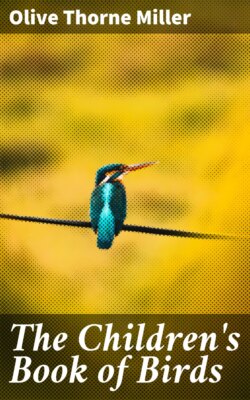Читать книгу The Children's Book of Birds - Olive Thorne Miller - Страница 12
На сайте Литреса книга снята с продажи.
V
ОглавлениеTable of Contents
HOW HE IS FED
Soon after the young bird comes out of the egg, he begins to be hungry. All day long, whenever the father or mother comes near, he opens his great mouth as wide as he can, to have it filled, and the moment he gets his voice he cries for food.
Then the old birds have to work hard. Three or four hungry nestlings can keep both father and mother busy from morning till night, hunting for caterpillars and beetles and grubs and other things to feed them. It seems as if the little fellows never could get enough to eat. Each swallow baby wants seven or eight hundred small flies every day, and a baby robin needs more earthworms in a day than you can hold in your hand at once.
At this time you will see robins hunting over the lawn, and carrying great beakfuls of worms up to the nest. Bluebirds you will find looking in the grass, and sparrows hopping about on the ground, all seeking soft worms and grubs and insects for the nestlings; and they are so busy they do not get much time for singing.
RUBY-THROATED HUMMINGBIRD
At this time the orioles go all over the orchard trees looking for tiny worms, and little warblers seek them under every leaf.
Woodpeckers find the insects hidden behind the bark of trees, by cutting holes through it. Chickadees and nuthatches pick the tiniest insect eggs out of the crevices, and flickers hunt everywhere for ants.
As soon as one of the old birds has his mouth full, he flies to the nest to feed the young.
But not all birds feed in the same way. A robin just drops a big earthworm, or a part of one, into the gaping baby mouth. Many other birds do so also. Sometimes, when an insect is too big or too hard, they beat it till it is soft, or break it up, before giving it to a little one.
But hummingbird mothers and flicker mothers have a different way. When they collect the food they swallow it, as if they wanted it for themselves. Then they go to the nest, and jerk it up again in mouthfuls, and feed the nestlings. This is called feeding by "regurgitation," or "throwing up."
The way they give the food is very curious. They push their long beaks into the nestling's throat, and poke the food far down; so the young one does not even have the trouble of swallowing.
This looks as if it must hurt, but the nestling seems to like it, and is always ready for more. The pigeon mother lets the young one poke his beak down her throat, and get the food for himself.
If the food is hard, like corn, birds who feed in this way let it stay in the crop till it is soft and better fitted for tender throats, before they give it out.
It is comical to see a nest full of little birds when the father or mother comes with food. All stretch up and open their big mouths as wide as they can, and if they are old enough, they cry as if they were starving.
Some birds bring food enough for all in the nest, every time they come. A cedar-bird, feeding wild cherries, brought five of them every time, one for each of the five nestlings. One cherry was held in his mouth, but the other four were down his throat, and had to be jerked up one by one.
Other birds bring only one mouthful at a time, and when there are five or six in the nest, they have to make as many journeys before all are fed.
Some persons who have studied birds think that each nestling is fed in its turn; but they look so much alike, and are so close together, that it is hard to tell, and I am not sure that it is so.
I will tell you a story I have heard about feeding little birds. A child picked up a young goldfinch who had fallen out of the nest. He took him home and put him into the canary's cage, which was hanging on the front porch.
Soon the family heard a great noise among the birds, and went out to see what was the matter. The baby goldfinch had hopped on to a perch in the cage, and seemed to be afraid to come down, though the old birds had brought food for him, and were calling him to take it.
The canary looked on a while, and then all at once he flew to the wires and took the food from the birds outside; then he went back to the perch beside the little one and gave it to him. This he did many times.
The next day another young goldfinch was picked up and put in the cage, and the canary took food from the parents and fed both.
After a few days the old birds came with a third little one, and as all were now old enough to fly, the cage door was opened, and they all flew away.
